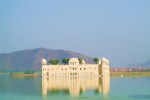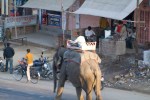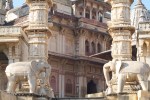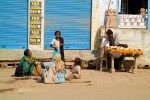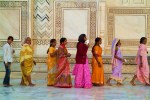Delhi is the starting point for many backpackers that want to experience northern India. It only takes about two minutes out of Gandhi International Airport to realize you have left many western comforts behind. Instantly, your senses are surrounded, and at some points, overwhelmed. India is a place where you can experience extreme beauty and also want to cancel the rest of trip within a matter of fifteen minutes.
The first thing that any visitor notices is that there are very few rules of traffic. Buses, cars, scooters, tuk-tuks, rickshaws, pedestrians, and animals share the streets. Intersections consist of everyone honking and inching their way through. As a pedestrian, you have to just walk out to cross the street. The traffic, which is moving at low speeds, if moving at all, will form around you. The only traffic pieces left from British colonial rule are the occasional roundabouts, and driving on the left side of the road.
The native language of Delhi residents is Hindi, which is also the national language of India. Almost everybody you meet will be able to speak Hindi. However, many people will also be fluent in English.
Because of its large size, Delhi is not really accessible to travel by foot. The cities overcrowded buses will overwhelm even the most seasoned traveler. Furthermore, the lack of street signs and navigational tools make this type of transit almost impossible. The best mode of transportation is to hire a driver. We had several personal drivers during our stay in India. When available, train travel is a great way to integrate into daily life in India. I had strangers share meals with me and provide hours upon hours of great conversation.
Delhi is divided up into New and Old Delhi. New Delhi was planned by Edwin Lutyens, a 20th century British architect. The city is known for its wide, tree-lined boulevards and houses numerous national institutions and foreign embassies. Old Delhi, is exactly that, old. One of the oldest inhabited places on the face of the earth – Old Delhi is believed to have been inhabited since 3000 B.C.
Most of the top tourist destinations are found in New Delhi. The India Gate and Rashtrapati Bhavan (Presidential Palace) are with in a short walk of each other. Many first time backpackers joke that India, stands for {I’ll-Never-Do-It-Again}. The main reason many westerners are can be stressed in India is the amount of begging and hassling around landmarks and tourists sights. However, besides tourist sites, I found university aged people to be very welcoming and interested in conversation.
Visitors may contract “Delhi Belly.” Avoid any ice or drink that is not bottled. Travelers should be careful of eating vegetables such as lettuce that have been washed in water or meat that could be spoiled. Luckily, I avoided this dreaded ailment with reasonable food choices.
Most backpackers expecting fabulous palaces are shocked when their first impressions are dominated by poverty instead. Prepare for the following:
- Begging. Foreigners are magnets for persistent beggars. Beggars, especially malnourished children and the badly deformed, can be particularly disturbing. Near any tourist site you will have one or multiple people talking/walking with you at all times. Do not be surprised if they make physical contact with you, eg. pulling on your arm, shirt, etc. This happened to me several times but I never felt in any real danger.
- Sanitation. Dirt, garbage and stray animals abound in the cities. Roadsides and sidewalk areas are also used as urinals.
- Noise. Drivers use their horns, a lot.
- Pollution. All Indian cities suffer very badly. Exhaust combined with dust, garbage, and human waste can make breathing difficult in large cities.
- Over-population. Indian streets and markets are jam-packed with people, be cautious of pick pockets. Still out of every country I have been to, the only place I have had someone attempt to pick pocket me was in Geneva, Switzerland. Arguably one of the richest cities on the planet.
If you had one trip left and wanted to see and experience as much as you possibly could in one country, India would have to be it.


